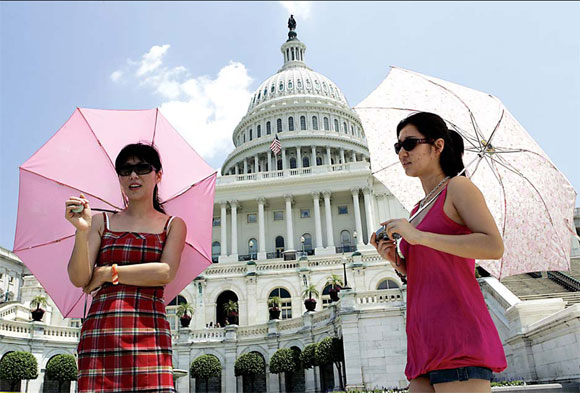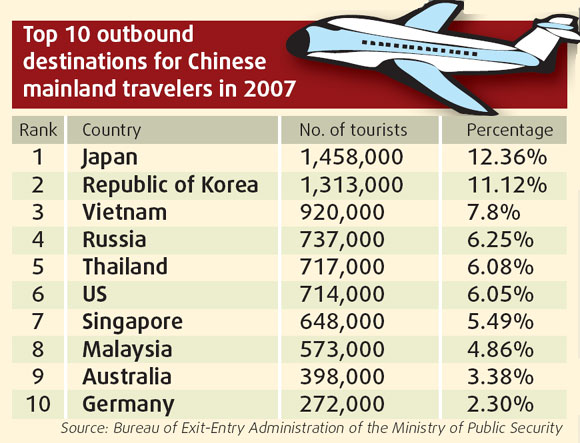
Visitors take in the sights on Capitol Hill in Washington DC on June 9. The United States is set to receive more tourists from the Chinese mainland as it has won "Approved Destination Status" under a recent Sino-US memorandum of understanding. AP
Beijinger Meng Xuegen's retirement dream is to see the world.
From France to Switzerland to Russia, the 67-year-old has traveled with his wife to every destination on their must-go list except for one: the United States.
But that country too will soon be crossed out.
Setting off tomorrow, Meng is among the first group of Chinese tourists going to the US after the two governments signed a memorandum of understanding (MOU) last December, which allows Chinese tourist groups to travel in the US.
The MOU saw the US granted "Approved Destination Status" after years of negotiation, making it the 134th country on China's approved list.
"I am going to the States to see the 'paper tiger'," Meng joked.
"After all, America is the most developed capitalist country in the world, so I want to take a look at it."
For ordinary Chinese citizens, the MOU has eased a decades-old restriction on travel to the US and opened the door of popular US tourist attractions to people like Meng, who have the money, time and desire to travel the world.
"New York is the city I most want to visit. I am also excited about the trip to Pearl Harbor of Hawaii," said Meng, who was born in 1941, the year when the Japanese attacked the US Pacific fleet at the harbor and pushed the Americans into World War II.
In the past, most Chinese who traveled to the US were either students or business people. Under the latest tourism agreement between the two countries, the balance is expected to shift to more leisure travel.
As the agreement takes effect today, travel agencies in both countries expect a new wave of Chinese traveling to the US for leisure.
Chinese travel agencies can now actively advertise and market US leisure tour packages. Under the agreement, they are able to run commercials and organize events such as the US Tour Week to promote products and services.
"It would have been against the law in the past," said Lin Kang, deputy general manager of the outbound department of the China International Travel Service (CITS). The company is one of the authorized tour agencies to operate Chinese tour groups to the US.
Lin said the outbound travel market has had a difficult time this year. Faced with domestic inflation, a falling stock market and the upcoming Olympic Games, many people have been choosing to stay at home rather than travel abroad.
Domestic travel agencies like CITS hope the opening up of the US market will turn the situation around.
"As the world's largest economy, the US market possesses huge potential unmatched by any other country. We hope the newly opened US destinations can help boost the weak outbound travel market this year," Lin said.
The US market currently makes up only about 10 percent of total profits of the company's outbound tourism, Lin said. He hopes that the proportion rises to a third of the total profits in the future.
Similarly, the impact of a rapidly growing Chinese tourism market is starting to be felt on US shores.
Amid talk of an economic recession, many top US destinations are looking to the tourism industry as a bright spot for the local economy.
"A strong tourism industry is critical in seeing any city through tough economic times, not only because of hotel taxes, sales taxes and local employment, but also purely because of visitor spending," said George Fertitta, chief executive officer of the NYC & Company, the official marketing and tourism organization of New York.
"With Chinese tourism at a steady annual increase, we think the MOU will only continue to strengthen this trend, and I think we will find that China will be one of our top travel markets in the next few years," he said.
Tourism experts predict that Chinese tourism to the US will expand by 46 percent between 2005 and this year. The number of Chinese visitors to the US will also reach 579,000 by 2011, the US Department of Commerce has projected.
To keep up with the demand, hotel development has been rising throughout the city of New York. By the end of this year, the city will boast an increase of more than 3,000 new hotel rooms, and more than 13,000 by 2010, the NYC & Company has said.
The city has also gone on to print a guide in simplified Chinese and started to hire more Mandarin-speaking representatives at its tourist office to accommodate the growth of Chinese visitors.
The tourist dollars brought into the US by Chinese travelers have already been boosting the economy. On average, Chinese travelers spend about $6,000 a visit to the US, more than tourists of any other country, figures released by the US Department of Commerce showed.
Meng said his shopping budget for his upcoming US tour is $2,000.
"I made only 50 yuan ($7.20) a month in 1970s. Now I can easily afford a 12-day tour to the US, which would be unimaginable 30 years ago."
Gathering momentum
With a new affluent middle class emerging, China has become a rapidly growing tourist source country since its opening up in the late 1970s. The sheer number of potential travelers and the strong purchasing power held up by the stronger yuan have made Chinese tourists a highly desired market.
Figures from the Chinese National Tourism Administration showed that 40.9 million Chinese citizens traveled abroad last year, an increase of 19 percent from 2006. The UN World Tourism Organization forecast the number to hit 100 million in 2020, making China the world's fourth-largest source of outbound tourists.
Lisa Simon, president of the National Tour Association (NTA), said she expects the China traffic to pick up quickly.
The NTA administers the list of bona fide US tourism companies that Chinese companies use for finding partners in the US.
While there are still fears that a lengthy and tiresome visa application process will remain a nuisance for most Chinese tourists to the US, new arrangements have been made to make the process more convenient, the US Embassy in Beijing has said.
"A new special appointment channel is now available for authorized travel agencies to book group tourist interview appointments in Beijing, Shanghai and Guangzhou," said US embassy spokeswoman Susan Stevenson.
"Tour leaders can also now enter the visa hall with tour groups from their agency for the visa interview," she said.
While the US embassy and consulates have made group tour appointments a priority, individual interviews and fingerprints are still required.
A few restrictions remain in place under the latest agreement.
Only residents of nine Chinese municipalities and provinces may apply for US travel: Beijing, Tianjin, Hebei, Hubei, Hunan, Shanghai, Jiangsu, Zhejiang and Guangdong. Other provinces are expected to join by the end of the year.
The US retains the right to terminate the agreement if large numbers of tourists begin to overstay their visas.
The US Department of State may also create a facilitated visa procedure for the unprecedented numbers of Chinese group tourists being expected.
Meanwhile, Meng said he is already thinking of adding new places to his travel list after his US trip.
"Taiwan will probably be on top of it," he said.

(China Daily June 17, 2008)